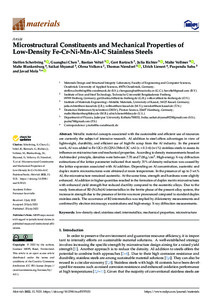Microstructural Constituents and Mechanical Properties of Low-Density Fe-Cr-Ni-Mn-Al-C Stainless Steels
| dc.date.accessioned | 2023-08-02T11:46:09Z | |
| dc.date.available | 2023-08-02T11:46:09Z | |
| dc.date.issued | 2022-07-23 | |
| dc.identifier | doi:10.17170/kobra-202308028567 | |
| dc.identifier.uri | http://hdl.handle.net/123456789/14969 | |
| dc.language.iso | eng | |
| dc.rights | Namensnennung 4.0 International | * |
| dc.rights.uri | http://creativecommons.org/licenses/by/4.0/ | * |
| dc.subject | low-density steel | eng |
| dc.subject | stainless steel | eng |
| dc.subject | intermetallics | eng |
| dc.subject | mechanical properties | eng |
| dc.subject | microstructure | eng |
| dc.subject.ddc | 620 | |
| dc.title | Microstructural Constituents and Mechanical Properties of Low-Density Fe-Cr-Ni-Mn-Al-C Stainless Steels | eng |
| dc.type | Aufsatz | |
| dcterms.abstract | Metallic material concepts associated with the sustainable and efficient use of resources are currently the subject of intensive research. Al addition to steel offers advantages in view of lightweight, durability, and efficient use of high-Fe scrap from the Al industry. In the present work, Al was added to Fe-12Cr-(9,12)Ni-3Mn-0.3C-xAl (x = 0.1–6) (wt.%) stainless steels to assess its influence on microstructure and mechanical properties. According to density measurements based on Archimedes’ principle, densities were between 7.70 and 7.08 g/cm³. High-energy X-ray diffraction estimations of the lattice parameter indicated that nearly 31% of density reduction was caused by the lattice expansion associated with Al addition. Depending on Al concentration, austenitic and duplex matrix microstructures were obtained at room temperature. In the presence of up to 3 wt.% Al, the microstructure remained austenitic. At the same time, strength and hardness were slightly enhanced. Al addition in higher quantities resulted in the formation of duplex matrix microstructures with enhanced yield strength but reduced ductility compared to the austenitic alloys. Due to the ready formation of B2-(Ni,Fe)Al intermetallics in the ferrite phase of the present alloy system, the increase in strength due to the presence of ferrite was more pronounced compared to standard duplex stainless steels. The occurrence of B2 intermetallics was implied by dilatometry measurements and confirmed by electron microscopy examinations and high-energy X-ray diffraction measurements. | eng |
| dcterms.accessRights | open access | |
| dcterms.creator | Scherbring, Steffen | |
| dcterms.creator | Chen, Guanghui | |
| dcterms.creator | Veltel, Bastian | |
| dcterms.creator | Bartzsch, Gert | |
| dcterms.creator | Richter, Julia | |
| dcterms.creator | Vollmer, Malte | |
| dcterms.creator | Blankenburg, Malte | |
| dcterms.creator | Shyamal, Saikat | |
| dcterms.creator | Volkova, Olena | |
| dcterms.creator | Niendorf, Thomas | |
| dcterms.creator | Lienert, Ulrich | |
| dcterms.creator | Sahu, Puspendu | |
| dcterms.creator | Mola, Javad | |
| dcterms.extent | 20 Seiten | |
| dc.relation.doi | doi:10.3390/ma15155121 | |
| dc.subject.swd | Mechanische Eigenschaft | ger |
| dc.subject.swd | Nicht rostender Stahl | ger |
| dc.subject.swd | Mikrostruktur | ger |
| dc.type.version | publishedVersion | |
| dcterms.source.identifier | eissn:1996-1944 | |
| dcterms.source.issue | Issue 15 | |
| dcterms.source.journal | Materials | eng |
| dcterms.source.volume | Volume 15 | |
| kup.iskup | false | |
| dcterms.source.articlenumber | 5121 |
Dateien zu dieser Ressource
Das Dokument erscheint in:
-
Publikationen [75]


